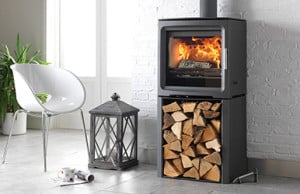 Although we manufacture multi-fuel stoves in a wide range of styles, designs and sizes, there are other members of the stove family, which help make up this diverse yet closely related range of heating powerhouses.
Although we manufacture multi-fuel stoves in a wide range of styles, designs and sizes, there are other members of the stove family, which help make up this diverse yet closely related range of heating powerhouses.
In this article we look at a few of the less well know stoves that were used in years gone-by, and sometimes still today.
1. The Camping Fire – While this is not strictly a wood burning stove in any sense of the word, apart from it uses wood, the humble camp fire has been used pretty much since humans walked the earth, and is the forefather and founder of what we today know as the high efficiency wood burning stove. Whilst this is not a stove it certainly deserves a mention.
2. The Open Fire – A step up in evolution terms from the camp fire is the traditional open fire – an inspiration base for many modern stoves and gas fires. Although these look great in older homes, they are highly inefficient compared to new high efficiency stoves. Around 75% of the heat they produce is lost. In comparison, a high efficiency stove will only lose only around 20%.
3. The Masonry Stove – These stoves use a cleaver network of heat-exchange passages. They store hot gases from a fire before they leave though the chimney. The heat energy is stored and then slowly released over a period of hours, or in some cases days.
4. The Potbelly Stove – The bulging mid-section easily identifies this stove – hence the name. It first appeared in the 1860’s and was often found in rail station waiting rooms and schools. It could use either wood or coal. The more exotic potbelly stoves were called parlor stoves, which were decorated and often a little larger. They were found in affluent properties mostly.
5. The Cooking Stove – Some people refer to their regular oven/hob as a stove, more as a force of habit than anything else. However, in years gone-by many people used wood-fired stoves to cook their food, which were designed in the form of a oven/hob set up, where the wood would burn and heat up the hob plates and oven sections. This was very popular in the late 19th century.
6. The Foot Stove – This unusual stove was a wooden box, which is open on one side, along with holes on the top. Inside the stove, a pottery bowl (or sometimes a metal one) was placed, which had charcoal in. The feet were positioned on top of the stove to become warm. This type of stove was useful in houses that were often very cold, a common problem in the homes of 19th century Great Britain. A foot stove was not designed to cook anything, apart from feet maybe!
In Conclusion
Stoves have advanced greatly in recent years. In the past they were a staple part of home life, for cooking and keeping warm. As things progressed we used stoves less for heating and more for enjoyment, and as “talking points” in a home. However, as the world becomes more environmentally focused, there is a shift back to renewable energy and sustainability. This is one reason why wood burning stoves are becoming so popular, not for just looking great in a lounge, but also for a primary source of heat in a home.
View our range of stoves on our gallery.








